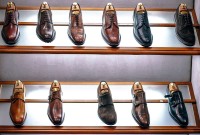- Home
- Business Processes
- Industry Knowledge
- Aerospace Industry
- Automotive Industry
- Banking Domain
- BFSI Industry
- Consumer/ FMCG Industry
- Chemicals Industry
- Engineering & Construction
- Energy Industry
- Education Domain
- Finance Domain
- Hospitality Domain
- Healthcare Industry
- Insurance Domain
- Retail Industry
- Travel and Tourism Domain
- Telecom Industry
- Leadership Skills
- eLearning
- Home
- Domain Knowledge
- Retail Industry
- Retail Industry: Revenue Model
Retail Industry: Revenue Model
Understand the traditional retail revenue model and, what are the variations in different revenue models adopted by key players in the retail industry. Analyze the pros and cons of various models. The most common and most profitable revenue model is that of the traditional retailer. The traditional retailer profits by selling products and services directly to buyers at a mark-up from the actual cost.
Revenue Models – Retail:
Successful retail operations depend largely on two main dimensions: margin and turnover. How far a retail enterprise can reach in margin and turnover depends essentially on the type of business (product lines) and the style and scale of the operations. In addition, the turnover also depends upon the professional competence of the enterprise. Margin is defined as the percentage mark tip at which the inventory in the store is sold and turnover is the number of times the average inventory is sold in a year.
In a given business two retail companies may choose two different margin levels, and yet both may be successful, provided the strategy and style of management are appropriate.
Given below are some revenue models adopted by the players of the retail industry:
1. Low Complexity, Low Margin, High Turnover Potential
The most common and most profitable revenue model is that of the traditional retailer. The traditional retailer profits by selling products and services directly to buyers at a mark-up from the actual cost. In the first model, the retailer assumes that low price is the most significant determinant of customer patronage. Low-cost retailers generally sell to the mass market with a strong emphasis on price over quality or other premium product/service attributes.
The stores in this category price their products below the market level. Marketing communication focuses mainly on price. Low-cost retailers typically offer a high number of SKUs at the best possible price. By emphasizing price, the low-cost retailer operates on very low margins and must have the market power to negotiate deep discounts from its suppliers, coupled with significant operational efficiencies. They provide very few services; if any, and they normally entail an extra charge whenever they do. The merchandise in these stores is generally pre-sold or self-sold. This means that the customers buy the product, rather than the store selling them.
Amazon and Wal-Mart serve as the best examples of low-cost retailers. Wal-Mart benefits from its vast size in the physical retail space, leveraging its volume operations in the digital space. Amazon has created its own efficiencies using digital technology. Pantaloon Chain and Flipkart are the Indian examples of such stores.
2. High Margin Low Turnover
This operation is based on the premise that distinctive merchandise, service, and sales approach are the most important factors for attracting customers. Premium retailers target highly segmented markets with an emphasis on prestige, quality, and performance much more than price. Stores in this category price their products higher than those in the market, but not necessarily higher than those in similar outlets. Many premium retailers find that higher prices positively correlate to the prestige of the brand. In many cases, the premium retailer sells its own branded products instead of reselling other brands. The focus in marketing communication is on product quality and uniqueness.
Merchandise is primarily sold in store and not pre-sold. These stores provide a large number of services and sell select, categories of products. They do not stock national brands that are nationally advertised. These retailers manufacture their own or work with contract manufacturers to develop name brand products for sale at premium prices. Typically, a store in this category is located in a downtown area or a major shopping center. Sales depend largely on salesmanship and image of the outlet.
Williams-Sonoma and Victoria's Secret are examples of premium retailers who have developed their own mainstream premium product category by selling quality, private-label products. Gilt Groupe is an example of a digital premium retailer that has created an outlet to sell other premium brands to a targeted group of customers.
3. High Margin High Turnover Stores
These stores generally stock a narrow line of products with a turnover of reasonably high frequency. Cost-plus retailers generally sell to a segmented mass market, trying to maintain comfortable margins instead of focusing on price, and justifying those margins through quality, service, and selection.
They could be situated in a noncommercial area but not too far from a major thoroughfare. Their locational advantage allows them to charge a higher price. High overhead costs and, low volumes also necessitate a higher price. Most cost plus retailers choose specific product segments, such as computers and electronics or office supplies, and develop a level of expertise that mass-market retailers cannot match. Others may offer a broad product offering but emphasize shopping experience or a higher level of customer service.
Staples and Best Buy represent the best examples of cost-plus retailers that focus on specific product categories, while Target is a good example of a cost-plus retailer that offers a broad array of products.
4. Low Margin-Low Turnover Stores
Retail enterprises in this category are pushed to maintain low margins because of price wars. Compounding this problem is the low volume of sales, which is probably a result of poor management, unsuitable location etc. such businesses, normally get wiped out over a period of time. These retailers spend most of their time fighting for sales volume and trying to build customer loyalty.
Related Links
You May Also Like
-
The retail value chain defines a series of actions that enable businesses to sell their products to customers. Value Chain for any industry describes how an industry is structured and its methods for maximizing revenues. Learn the value chain of the industry. Learn about the key partners, key activities, cost structures, and revenue streams of the retail sector. The value/supply chain analysis reveals the business activities which comprise the movement of retail goods.
-
Competitive Landscape of Retail Industry
In an increasingly competitive landscape, retail industry players must compete in a number of ways. In this article, we will learn about the competitive landscape of the retail industry. Learn the key players in the retail industry and their business profile. Learn more about the top 5 industry players. Competition is rough, especially for the small business. Knowing how business stacks up to the competition is important to your business strategy.
-
Consumers benefit from retailing as retailers perform marketing functions that make it possible for customers to have access to a broad variety of products and services. Retailing also helps to create a place, time, and possession utilities. A retailer's service also helps to enhance a product's image. Retailing has a tremendous impact on the economy. It involves high annual sales and employment. Learn the importance of the retail industry in this article.
-
Retail Industry - Business Model
A retail business model articulates how a retailer creates value for its customers and appropriates value from the markets. In retail, a business model would dictate the product and/or services offered by the retailer, the pricing policy that he adopts. Many different types of retail establishments exist, and, the overall industry has seen a significant blurring of the boundaries that separated the wide range of retail businesses. Understand the key business models adopted by the retail industry. Understand the distinctive ways that retail industry players use to reach to the end consumer.
-
Retail Industry: Key Performance Metrics
You cannot manage what you do not measure and cannot measure what you do not define. Learn the key performance metrics for the retail industry like Sales per square foot, Gross margins return on investment, Average transaction value, Customer retention, Conversion rate, Foot traffic, and digital traffic and Inventory turnover, etc. These metrics are used across the globe by key industry players to track and improve their performance.
-
Challenges in Consumer Goods Industry
There are tens of thousands of general consumer products manufacturers in the United States. They compete to develop the best products at the most affordable price for the greatest number of consumers. Challenges for these organizations include meeting the changing demands of customers, maneuvering through a consolidating market, and executing strategies to grow profitably.
-
Retail Industry: Revenue Model
Understand the traditional retail revenue model and, what are the variations in different revenue models adopted by key players in the retail industry. Analyze the pros and cons of various models. The most common and most profitable revenue model is that of the traditional retailer. The traditional retailer profits by selling products and services directly to buyers at a mark-up from the actual cost.
-
Retail Industry – Drivers & Dynamics
To succeed in the retail sector, retailers must offer compelling value propositions and be responsive to market dynamics. The continued rise of e-commerce has altered the dynamics of the retail industry in such a way that has forced retailers to drastically reallocate their resources to multi-channel strategies. This article focuses on retail industry drivers and dynamics that provide the reader with a basic understanding of the factors that influence this trade. Understand the business drivers and dynamics of retail industry
-
Retail Industry Sectors: Types of Retail
A marketplace is a location where goods and services are exchanged. The traditional market square is a city square where traders set up stalls and buyers browse the merchandise. Now retail goods are generally sold in a number of different establishments. Convenience Stores, specialty stores, department stores, supermarkets & hypermarkets, discount stores, multichannel stores are some models used by the retail industry to provide goods to end customers.
-
Retailing is the combination of activities involved in selling or renting consumer goods and services directly to ultimate consumers for their personal or household use. In addition to selling, retailing includes such diverse activities as, buying, advertising, data processing, and maintaining inventory. This article explains the meaning of retail and its etymology. Understand the meaning and constituents of the retail industry and the role it plays in the economy of any nation.
Explore Our Free Training Articles or
Sign Up to Start With Our eLearning Courses

About Us
Learning
© 2023 TechnoFunc, All Rights Reserved










